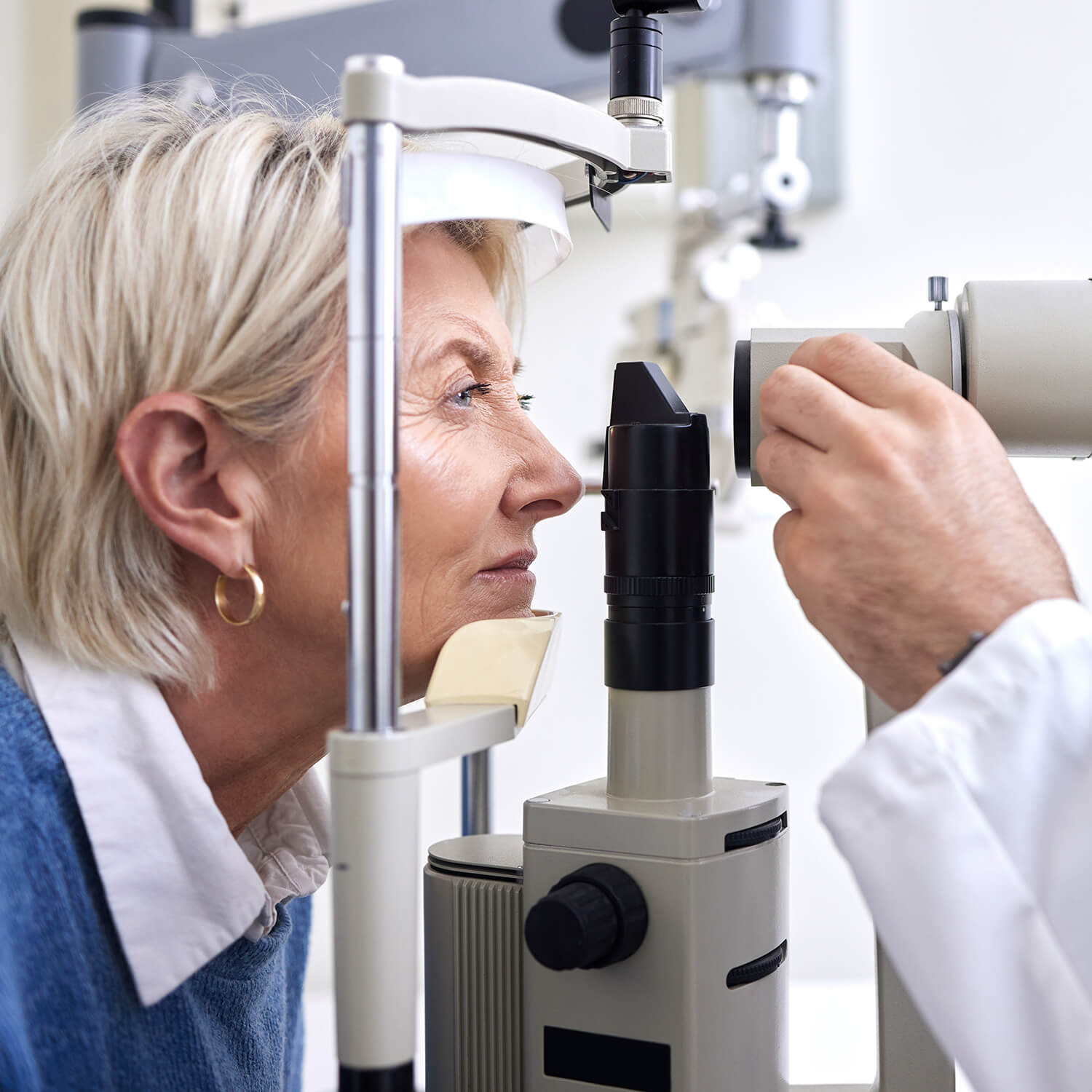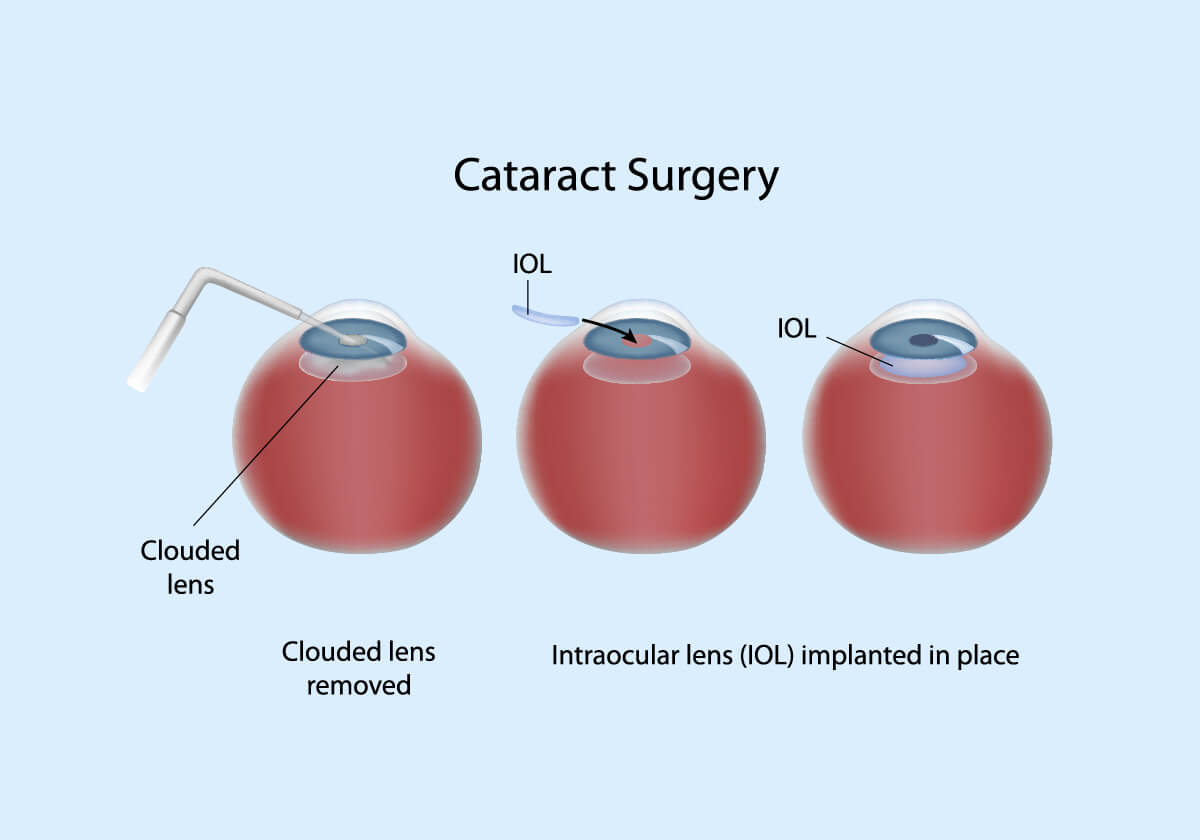Cataract Symptoms


What is a Cataract?
As we age, the lens of our eye naturally starts to become cloudy. This is called a cataract. Like a foggy window, a cloudy lens is difficult to see through. Most people over the age of 65 have already developed some clouding of their lenses; it just hasn’t begun to affect their vision yet. But as cataracts progress, it becomes increasingly more difficult to see and do the everyday things you enjoy.
Cataracts can affect one or both eyes and are a normal part of the aging process. Factors such as smoking, diabetes and high blood pressure will accelerate cataract development. The good news is that cataract surgery and IOL implantation can quickly and painlessly replace the cloudy lens with a new, clear, artificial lens implant, restoring your vision.
Are you seeking a Los Angeles cataract surgeon? We invite you to take our cataract self-evaluation test or schedule a cataract evaluation today. We treat every patient individually and provide unique patient care with modern cataract solutions.
Schedule Your ConsultationDo You Think You Might Have a Cataract?
Cataract Symptoms
Cataracts develop at different times for everyone, and most people won’t even notice them at first. Gradually, your lens will become cloudier, until it causes:
- Glare, halo, and increased difficulty with night driving
- Blurry or cloudy vision
- Appearance of halos or glare
- Difficulty seeing clearly even after updating your glasses prescription

Cataract Evaluation
Our goal is to provide you with the most accurate and unbiased information possible, so that you may make the best decision for your vision. We understand that to choose to undergo any surgical procedure requires careful consideration and planning. Our comprehensive cataract consultation is designed to help us get to know you, understand your visual needs, and assist you in understanding your options.
We’ve helped thousands of cataract patients improve their vision and quality of life over the years. If you or a loved one think you may have cataracts, or are interested in lens replacement care, schedule your consultation today. We’ll be happy to evaluate your vision, and help determine the best course of action for your visual needs.
Schedule Your ConsultationFrequently Asked Cataract Questions
Q: What if I have astigmatism? Can this be corrected in the visual outcome of cataract surgery?
Q: What happens if I choose not to have cataract surgery?
Options For Seeing After Cataract Surgery at Near, Far and Intermediate Distances
At LA Sight you will have various options for how you want to see your world after cataract surgery. It is critical that you meet with Dr. Moarefi, our LA Sight cataract surgeon for a thorough eye health exam, cataract diagnosis, and discussion of your surgical options. After surgery many of our patients do not require glasses and enjoy an active lifestyle without the hassles of glasses.
Anyone who elects to have cataract surgery with a conventional, older-style lens implant will have their cloudy natural lens removed and replaced with a monofocal intraocular lens (“IOL”). Typically this lens implant will provide very good visual results, and clarity will be promptly restored. Standard monofocal lens implants do not, however, correct for astigmatism or presbyopia. Therefore, it is very likely that glasses will be necessary after IOL care, both for optimum distance vision (if astigmatism is present), and very likely for reading. For many, a standard lens implant is a fine option — it’s nice to have clarity, and enhanced quality of life — even if glasses are still helpful for obtaining optimal sharpness at far and near.
Newer Lifestyle IOLs provide a fuller range of vision after surgery, along with improving visual clarity. Presbyopic lens implants help you see at a fuller range, from near to distance, greatly reducing any need for reading glasses afterwards. Astigmatism-correcting implants eliminate pre-existing astigmatism in one step, and the time of initial surgery, significantly improving distance vision quality and clarity.
Refractive Services
At LA Sight, we provide lifestyle IOLs in combination with other specialized care referred to as Refractive Services. This includes discussing your visual needs, interests, preferences and habits; then custom-tailoring a vision plan specifically for you. We do detailed surgical planning, take confirmatory measurements during surgery, and utilize techniques during surgery to reduce or eliminate astigmatism. We also are able to fine-tune the results if needed, by doing LASIK when warranted, to achieve a desired optical “target” and best visual results.
Combining Lifestyle IOLs with Refractive Services can correct virtually all optical imperfections including nearsightedness, farsightedness, and astigmatism. Certain premium lenses can also dramatically reduce the need for reading glasses in a very high percentage of patients.
Our Refractive Services package allows us to confidently deliver a desired optical outcome with cataract and IOL care. We recognize that your vision is critical; and that cataract care is an important investment in your visual well-being. The portfolio of Refractive Services allows us to achieve extremely high-precision visual outcomes.
While PPO or traditional health insurance will cover some or most of the costs associated with cataract care, this does not extend to Refractive Services. Therefore, Refractive Services and the extra costs of Lifestyle IOLs are the responsibility of the patient.
In a perfect world, eye surgeons would be able to implant auto-focusing lenses so that everyone could see perfectly at every distance, near or far, under any lighting condition, day or night. To put it mildly, we’re not there, yet. However, with careful evaluation, discussion of available options, and tailoring of care to individual situations, we can create very functional visual solutions for the patients we serve.
If you’d like to take the next step, schedule a consultation with Dr. Moarefi.
Schedule Your ConsultationCataract IOL Options at LA Sight
Recover Clear Vision at Far and Near
In our busy, multi-tasking world, we want to — need to — see perfectly at many different distances. We all read, use cell phones, tablet devices, desktop computers. We read newspapers, magazines, books, and the tiny print on prescription medication bottles when necessary. We enjoy athletic pursuits and sports, most of which benefit from exceptional vision at far distance. When we drive, we want to see freeway signs hundreds of yards away, and our dashboard, and occasionally check email or texts on our phones.
So as good as monofocal IOLs may be, they’re not close to a perfect solution. We still have not developed the perfect, adjustable-focus IOL to replace the natural young human lens, but multifocal IOLs add a whole set of features and benefits that are not possible with monofocal IOLs.
Multifocal IOLs work by having concentric zones of different focus, alternating far and near. This affords very good distance and reading clarity. These lenses do need to optically split the incoming light into two points of focus, so they do cause some reduction in contrast sensitivity (fine detail detection in low light). And the concentric rings do cause a bit of halo to be perceived around point sources of light at night such as headlights, taillights and street lights. The overwhelming majority of people that have had multifocal IOLs implanted are extremely happy with their overall visual function, and don’t mind these imperfections, which they perceive to be minor. Whether you will be an optimal candidate for multifocal IOL care will be assessed and discussed at your comprehensive cataract and IOL consultation.
Dr. Amir Moarefi is a highly skilled lens implant surgeon. He has treated many cataract patients, as well as those seeking clear lens replacements.
Astigmatism-correcting IOLs can permanently correct astigmatism and improve distance vision in a single step.
Toric lens implants are astigmatism-correcting IOLs designed with a specific shape that counterbalances the corneal curvature imperfection that creates astigmatism in the first place. Toric IOLs refocus light rays as they pass through the lens. The result is a near-perfect and long-lasting correction of astigmatism, along with a complete restoration of distance vision. This lens is a wonderful option for anyone over 50 who has pre-existing astigmatism.
Traditional monofocal IOLs provide good vision (correcting nearsightedness or farsightedness), but do not correct for other optical imperfections including astigmatism, presbyopia, or spherical aberration. This is a type of optical imperfection that can cause increased glare, and reduced overall quality of vision in low light and darkness. Lenses that correct for spherical aberration are called aspheric lenses. If you notice any reduction in night vision clarity before IOL care, this may be only partially corrected by standard monofocal IOLs. That’s why most IOLs these days incorporate aspheric optics.
Aspheric IOLs are monofocal lenses that correct for spherical aberration. The result is a lens that will provide better overall vision than traditional IOLs, especially at night.
Patients who choose an aspheric IOL can expect:
- Improved contrast sensitivity
- Enhanced functional vision
- Superior night driving ability
There are several acceptable options for the preferred vision target after IOL care. Some people will be happier having both eyes corrected for optimum distance vision. This affords the best balance between the two eyes, and the best depth perception. Others will prefer having one eye adjusted for optimum distance viewing and the other eye adjusted for intermediate or near range viewing. This is referred to as monovision.
With full binocular distance vision, you can expect to have dramatically enhanced distance vision with spectacular clarity and improved visibility in low light. This option will not correct for presbyopia so you will still need to wear readers to view things at close range.
If you’re ready to take the next step, then schedule your Lens Evaluation today. Dr. Amir Moarefi is a highly skilled lens implant surgeon. He has treated thousands of cataract patients, as those seeking clear lens replacement.
Schedule Your Consultation"If you're considering getting Lasik, Dr. Moarefi should be your go-to guy. From start to finish, my experience with him and his team was exceptional. Dr. Moarefi is not only an expert in his field but also incredibly charismatic and patient."

What Happens During Cataract Surgery?
When you arrive at the eye surgery center, the staff will wash and clean the area around your eyes. Drops are then inserted to dilate your pupils. Anesthetic eye drops will numb the eye, and you should feel no pain. Most patients are awake during the procedure. You may be given medication to help you relax. Dr. Moarefi, your LA Sight eye surgeon, will enter the eye through tiny incisions. The next step is to remove the clouded natural lens from your eye and replace it with the artificial intraocular lens (IOL). Stitches are not usually required and the tiny incisions close on their own.
What Happens After Surgery?
Your eye will be covered to protect it for at least 24 hours. You will need prescription eye drops at regular intervals for a few weeks to help the eye heal and to prevent infection. Most patients report seeing very well the day after surgery, and often comment how bright and clear colors and fine detail are afterwards. Cataract formation is often so gradual, they hadn’t realized how washed out and muddy their vision had become. The best part? You can resume most activities within a few days after surgery, and your new vision will be with you for the rest of your life.
